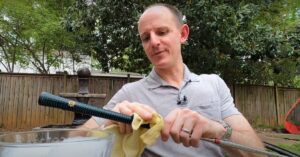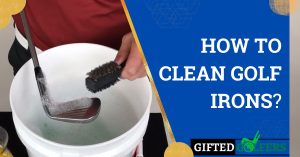Can Golf Carts Get Wet Or Be Left In The Rain? [Explained]
Golf carts are designed to handle various weather conditions, but knowing their limits in wet conditions is important. They are commonly used on golf courses, but what happens when it rains?
Golf carts can get wet, but it is not ideal. The batteries are the most important part of the cart to protect from water damage. If you are driving your cart in the rain, cover the batteries and keep them dry. You should also wipe down the cart after use to remove any moisture.
This blog post explores if golf carts can withstand rain and discusses precautions for their longevity.
How Do I Keep My Golf Cart Dry In The Rain?
Golf carts are valuable assets that require proper care and protection, especially during rainy weather.
Fortunately, you can take several effective measures to shield your golf cart from rain and moisture.
Follow the steps below to keep your golf cart dry and protected during rainy days.
Invest in a Waterproof Golf Cart Cover
A waterproof cover designed for golf carts is an excellent investment to protect your cart from rain.
Look for a high-quality cover that fits your cart’s dimensions and offers maximum water resistance.
Utilize Rain Enclosures
Consider installing a rain enclosure on your golf cart. These enclosures typically consist of clear vinyl panels that can be attached to the cart’s roof and sides, creating a protective barrier against rain and wind.
Check for Leaks and Seal Gaps
Inspect your golf cart for any leaks or gaps that could allow rainwater to enter. Pay particular attention to the roof, windshield, and seams.
Use weatherstripping or silicone sealant to seal any openings and prevent water from seeping in.
Keep the Golf Cart Parked Under the Shelter
Whenever possible, park your golf cart under a shelter, such as a carport or garage, during rainy weather. This will provide an added layer of protection and minimize exposure to rain.
Elevate the Golf Cart
If you can’t access covered parking, consider elevating your golf cart slightly to keep it off the ground.
Placing bricks or blocks under the tires will help prevent water from pooling around the cart and potentially damaging its components.
Use a Rain Hood for the Golf Bag
If you keep your golf bag on the cart, consider using a rain hood or cover for the bag. This will help keep your clubs and other belongings dry during transportation.
Dry the Cart Thoroughly
After driving your golf cart in the rain, make sure to dry it thoroughly. Use a clean towel or cloth to wipe off any moisture from the seats, roof, and other surfaces.
This will prevent the accumulation of water and minimize the risk of rust or damage.
Ensure Proper Drainage
Regularly inspect your golf cart to ensure proper drainage. Clean out any debris or leaves that may block the drainage channels or holes, preventing water from accumulating inside the cart.
Use Rain Deflectors
Rain deflectors, also known as rain curtains or windshields, are attachments that can be installed on your golf cart to divert rainwater away from the passengers and the cart’s interior.
These accessories are typically made of transparent material to maintain visibility.
Avoid Driving In Heavy Rain
Whenever possible, avoid driving your golf cart in heavy rain. Not only is it uncomfortable, but it also increases the risk of water damage.
If you must use your cart during inclement weather, try to schedule your trips during lighter rain showers.
Potential Risks Of Exposing A Golf Cart To Rain
Exposing a golf cart to rain can damage the vehicle by infiltrating electrical components, causing corrosion, affecting traction, and compromising performance and longevity.
Proper maintenance and protection are necessary to mitigate these risks.
Electrical Damage
Rainwater can seep into the electrical system of a golf cart, leading to short circuits, malfunctioning components, and potential damage to the battery.
The moisture can corrode connectors, wires, and circuit boards, rendering the cart inoperable or requiring costly repairs.
Corrosion
When exposed to rain, metal parts of the golf cart, such as the frame, body, and undercarriage, are susceptible to corrosion.
Over time, this can weaken the structure, compromise the cart’s integrity, and lead to aesthetic deterioration.
Traction and Performance
Rainwater on the golf cart’s tires and pathways can reduce traction, making it more challenging to navigate wet surfaces.
This can result in decreased control, increased slipping, and potential accidents.
Additionally, rain can affect the performance of the cart’s brakes, affecting stopping power and overall safety.
Battery Life
The golf cart’s battery is a crucial component that can be significantly impacted by exposure to rain.
Moisture can seep into the battery compartment, leading to internal damage, reduced capacity, and shortened battery life.
This can result in decreased operating time and the need for more frequent recharging or replacement.
Interior Damage
Rainwater entering the cabin or storage compartments of a golf cart can damage seats, upholstery, dashboard components, and other interior elements.
Stains, mold, mildew, and unpleasant odors can develop, requiring extensive cleaning or replacement of affected parts.
Cleaning And Drying Procedures After Rain Exposure
After a rainy day on the golf course, it’s important to properly clean and dry your golf cart to maintain its condition and prevent any damage. Follow these steps to ensure your golf cart remains in top shape
Gather The Necessary Supplies
- Soft bristle brush
- Mild soap or golf cart cleaner
- Clean towels or microfiber cloths
- Water hose with adjustable nozzle
- Leaf blower or air compressor (optional)
Step 1: Remove Any Loose Debris
Before starting the cleaning process, use a soft bristle brush or leaf blower to remove any leaves, dirt, or grass clippings from the exterior of the golf cart.
Step 2: Rinse The Cart
Use a water hose with an adjustable nozzle to rinse off the golf cart. Start from the roof and work your way down, ensuring that all areas are thoroughly rinsed.
Avoid using high-pressure settings to prevent damage to the cart’s electrical components.
Step 3: Clean The Body
Mix mild soap or a specialized golf cart cleaner with water in a bucket. Dip a clean towel or microfiber cloth into the soapy water and gently scrub the body of the golf cart, paying attention to any particularly dirty areas. Rinse the towel frequently to avoid spreading dirt.
Step 4: Clean The Wheels And Tires
Use the same soapy water mixture and a separate cloth to clean the wheels and tires. Pay attention to the treads and remove any mud or debris that may have accumulated.
Step 5: Dry The Cart
Once the golf cart has been thoroughly cleaned, use clean towels or microfiber cloths to dry the exterior. Wipe down all surfaces, including the seats and dashboard, to prevent water spots or potential damage.
Use A Leaf Blower Or Air Compressor (Optional )
If you have access to a leaf blower or air compressor, you can use it to blow out any water trapped in hard-to-reach areas such as crevices, wheel wells, or under the seat. This step helps ensure a more thorough drying process.
Frequently Asked Questions
Golf carts are designed to withstand some exposure to water, but it’s important to take precautions to prevent damage. Here are some frequently asked questions about whether golf carts can get wet or be left in the rain.
Can Golf Carts Get Wet from Driving on Wet Surfaces?
Yes, golf carts can get wet when driving on wet surfaces. However, it’s important to dry them off afterward to prevent water damage.
Should I Cover My Golf Cart If It’s Going to Rain?
Yes, it’s a good idea to cover your golf cart if rain is expected. Using a waterproof cover will help protect it from moisture and minimize the risk of water damage.
What Should I Do If My Golf Cart Gets Wet?
If your golf cart gets wet, dry it off as soon as possible using a clean towel or cloth. Pay attention to the electrical connections and battery compartment to prevent corrosion, and allow it to air dry completely before using it again.
Can I Wash My Golf Cart with Water?
Yes, you can wash your golf cart with water. However, avoid using excessive water pressure or directing water into the electrical components. Use a mild detergent, a soft cloth, or a sponge, and rinse it thoroughly. Remember to dry the cart afterward to prevent water damage.
Conclusion
Golf carts are designed to withstand light rain showers, but they should not be left in heavy rain or submerged in water.
Exposure to excessive water can damage electrical components, batteries, and upholstery.
It’s best to cover or store the cart indoors during heavy rainfall to protect it from potential damage.


![How to Clean Golf Balls? [Proven Methods for a Spotless Shine] How-to-Clean-Golf-Balls](https://giftedgolfers.com/wp-content/uploads/2023/09/How-to-Clean-Golf-Balls-300x157.jpg)


